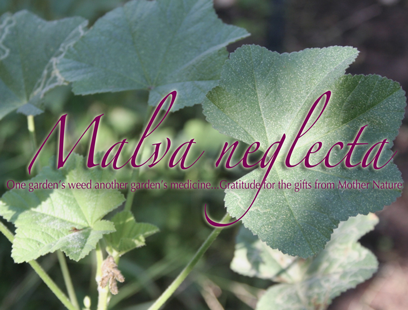It is said in permaculture that which you need will grow in your garden. After sitting with this plant for sometime and feeling it had so much to offer. She finally asked a friend to help her find its given name.
Here is a little wisdom from ‘she’s’ garden…thank you for David King for helping ‘she’ identify it…Gardenmaster, The Learning Garden (Almost) Daily Blog –
“Historians have traced Malva neglecta’s use as a vegetable back almost 3,000 years. The ancients used leaves and shoots as cooking greens and salad ingredients, while the seeds were used to accent dishes or as snacks. The plant’s traditional medicinal uses included soothing skin rashes and easing coughs. It was also used to reduce inflammation in the respiratory and gastrointestinal systems.
Edible Uses:
Leaves and young shoots of common mallow are edible raw or cooked. They have a mild pleasant flavor, and are said to be highly nutritious. They can be added in quantity to salads, and make an excellent lettuce substitute. They can also be cooked as greens. The leaves are mucus-forming, so when cooked in soups etc. they tend to thicken it in much the same way as okra. A decoction of the roots has been used as an egg-white substitute for making meringue. The roots are brought to the boil in water and then simmered until the water becomes quite thick. This liquid can then be whisked in much the same way as egg whites. A tea can be made from the dried leaves. Immature seeds are edible raw or cooked. Having a pleasant nutty flavor, they are nice as a nibble but too small in most cases to collect in quantity.
Caution:
When grown on nitrogen rich soils (and particularly when these are inorganic), the plant tends to concentrate high levels of nitrates in its leaves. The leaves are perfectly wholesome at all other times.
Medicinal Uses:
All parts of common mallow are astringent, laxative, urine-inducing, and have agents that counteract inflammation, that soften and soothe the skin when applied locally, and that induce the removal (coughing up) of mucous secretions from the lungs. The Cherokee Indians put the flowers in oil and mixed them with tallow for use on sores. The Iroquois Indians made a compound infusion of plants applied as poultice to swellings of all kinds, and for broken bones. They also applied it to babies’ swollen stomach or sore back. The Mahuna Indians used the plant for painful congestions of the stomach. The Navajo, Ramah Indians made a cold infusion of plants taken and used as a lotion for injuries or swellings. The plant is also an excellent laxative for young children.
Other Uses:
Cream, yellow and green dyes can be obtained from the plant and the seed heads. The root has been used as a toothbrush.”
References
Melissa Jordan-Reilly, LiveStrong
USDA; GRIN Taxonomy for Plants; Malva neglecta
Drugs.com: Common Mallow
Utah State University Extension: Common Mallow
World Health Organization: Quality Control Methods for Medicinal Plant Materials
Plants For A Future: Malva neglecta

Want to align, create and actualize your vision?…Moving through a Transition?
Want to reconnect with the Alchemy of Food for BIG and ‘Lil Kids?
or Explore Dreams {the Astral World}?
Connect with Suzanne one-on-one…visit SuzanneToro.com
Connect…
BeSimply Broadcasts BareNakedBliss on Amazon Facebook BareNakedExperience Twitter Etsy BeSimplyCafePress Bare Naked Bliss e-bookWant to reconnect with your environment and the alchemy of food?
Embrace the medicine of Essential Living Foods.

